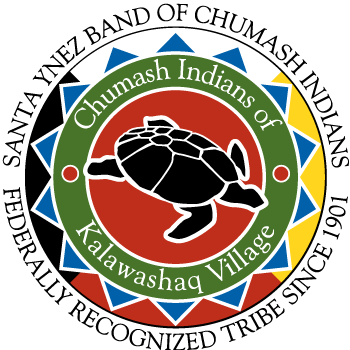Environment
Programs and Initiatives | Media | Connect with Us | Contact Us
Welcome to the Environmental Office of the Santa Ynez Band of Chumash Indians.
Established in 1998, the Santa Ynez Chumash Environmental Office (SYCEO) was founded in order to provide support to the tribal government and to serve the Chumash tribal community. It is our mission to prepare tribal lands for environmental adaptation, to protect and regenerate natural resources, and to cultivate the connection between culture, spirit, and community through collaboration and education.
SYCEO is composed of capable, talented individuals who are passionate about protecting the environment and improving the tribe’s environmental impact. Our team includes water quality specialists, environmental specialists, and environmental technicians. We also promote a number of programs to further our departmental mission, including the tribal nursery, zero waste efforts, community outreach, resources for water quality, wetland preservation, energy reduction, alternative fuels, sustainable landscaping, and hazard mitigation.
We welcome all to join us on a volunteer basis, or attend an upcoming event to have fun and grow more involved in protecting our environment. It’s a time-honored Chumash tradition — and one that couldn’t be more vital today.
Sincerely,
Julie Randall Colbert
Environmental Director
SYCEO has worked on numerous environmental projects in the past including: Sustainable Landscaping, Community Gardening, Alternative Fuels, Energy Resources, Flood Control, Habitat Restoration, and Measuring/Monitoring Water quality and Stream flow. Some of our most prevalent current projects include:
Community Outreach: SYCEO focuses on collaborating with other organizations to learn and share knowledge on different environmental practices. Our Learning Center also offers a homework club for young kids to become more familiar with their natural environment.
Tribal Nursery: SYCEO recently built a nursery to primarily grow culturally relevant native plants for traditional food, medicine, and fiber. For example: Chia Sage for food, Yerba Mansa for medicine, Juncus for fiber, etc. We also grow plants for ecological restoration purposes.
Water Quality: The SYCEO has monitored the water quality of Zanja de Cota Creek since 2008. Zanja de Cota Creek, a year-round flowing stream that meanders throughout the Chumash Reservation, is sampled on a monthly basis. Water quality data is used to evaluate overall ecosystem health and to help with identifying potential sources of pollution in the creek. Groundwater wells located on the reservation are also monitored each month by the SYCEO. Changes in the groundwater basin affect groundwater storage and baseflow in Zanja de Cota Creek. Monitoring consists of collecting depth-to-water measurements from each well.
Wetlands: Wetlands are areas of land that are covered by water, or that have saturated soil conditions, year-round or for varying periods throughout the year. Wetlands serve as transition zones between dry land and open water, protecting water quality by filtering out pollutants. They also provide natural flood control by soaking up runoff during heavy rainstorms and provide critical habitat for birds and animals. The SYCEO conducts wetland assessments to monitor and protect these culturally significant and sensitive habitat areas on the Chumash Reservation.
Zero Waste: SYCEO offers several waste diversion and disposal services to the Chumash community and Tribal Administration operations. SYCEO works toward the goal of zero waste through implementing and offering services for Tribal Hall, Culture, and Educational events. They collaborate with other organizations to help advance, or develop their zero waste programs.
Nonpoint Source Pollution: The SYCEO conducts nonpoint source assessments to identify and mitigate pollution areas of concern. Nonpoint source (NPS) refers to pollution that is not directly released into a water body but occurs when rainfall, snowmelt, and irrigation flows over and through the ground. As it moves over the land, it picks up and deposits pollutants into creeks/streams, rivers, lakes, wetlands, coastal waters, and groundwater. Some of the more common nonpoint source pollutants are 1) bacteria and nutrients from pet waste, livestock and faulty septic systems, 2) oil, grease, and gasoline/diesel fuels from roadways and parking lots, 3) sediment from eroding streambanks, improperly managed construction sites, and agricultural lands, and 4) pesticides, herbicides, and insecticides from agriculture and residential yards and gardens.
Maintaining the Reservation: SYCEO works to keep their own environment clean by doing monthly clean ups on the reservation.
Hazardous Waste: SYCEO collects hazardous waste from tribal residents to insure that they are safely disposed of and are no longer a threat to human health and the environment around them. Some of the most common hazardous materials collected include: latex paint cans, car batteries, and home cleaning sprays.
Air Program: SYCEO established an air program to monitor air quality on the reservation, with a focus on particulate matter from wildfires and potential air toxins from agricultural pesticide use. SYCEO has monitoring stations on the reservation and at Camp 4 to collect real time data.
Modern-day Technology: SYCEO utilizes modern-day technology to reach out to their community and other communities around them. They also use GIS and other mapping technologies for real time data. A weather station is also located inside of the learning center so that weather patterns can be analyzed.
Newsletter
Santa Ynez Chumash Environmental Office produces “Equinox,” a quarterly newsletter that includes department updates, upcoming events, educational information and more!
The most recent newsletter can be viewed below.

